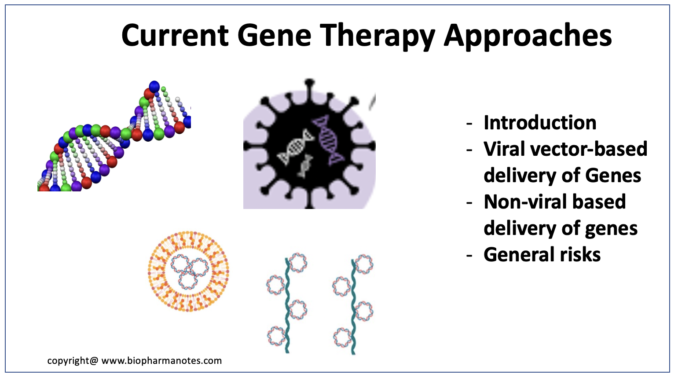
What is Gene Therapy?
Gene therapy is the use of gene modification or manipulation of gene expression for therapeutic purpose (FDA). Gene therapy works normally in three ways:
- By introducing new or modified functional gene into the body
- By replacing a faulty gene (disease causing) with a proper functional gene
- Or by inactivating the faulty gene
In gene therapy, the gene delivery systems comprise of viral, and non-viral delivery platforms along with oncolytic or suicide/prodrug, tumor suppressor and cytokine suppression gene therapy approaches. In cancer treatment, gene therapy includes the introduction of tumor suppressor genes or growth regulating genes, RNA interference (RNAi) to inhibit the activity of oncogenes. It can also involve the delivery of suicide genes which can convert non-toxic prodrugs into active anti-cancer compounds.

Figure- Ex-vivo and in-vivo strategy for treating genetic disease. Source: Bulaklak et al (2020).
Current Gene Therapy Approaches
Viral Vector Based Delivery of Genes
Adenoviruses Based : Adenoviruses are stranded DNA, non-enveloped viruses. Adenoviruses have many advantages for genetic manipulation, lower biosafety risk, high titers, and excellent safety profile. They are able to transduce both non-dividing and dividing cells with low risk of insertional mutagenesis. Adeno-associated viruses (AAV) is an example of Adenoviruses. AAV are non-pathogenic viruses which require a helper virus for replication inside host cell.
Retroviral Vectors (RV) Based: Retroviruses are single stranded RNA viruses (positive sense). The RNA genome is reverse transcribed into DNA which integrates into the genome of the host cell. Retroviruses can infect only dividing cells and shows stable expression of transgene. Examples of retroviral vectors are HSV.
Lentiviral Vectors: Lentiviruses are single stranded RNA viruses. In gene therapy, lentiviruses are widely used. LV are less prone to insertional mutagenesis and integrate into host genome. These are used in expression of silencing RNA and engineering of T cells for expression of chimeric antigen receptors.
Non-Viral Based Delivery of Genes
Polymers Based: Researchers are studying new polymers as a gene delivery system. Cationic polymers have been identified as useful for gene delivery. They have high potential for loading as they can neutralize negatively charged genetic material and carry them to targeted cells. Some examples include chitosan, polylactide (PLA), a mixture of neutral and negative lipids 1,2-dipalmitoylphosphatidylcholine (DPPC) and bis(monoacylglycerol)phosphate (BMP).
Lipid Based: Mostly lipids are with positively charged headgroups which binds with negatively charged nucleic acid and for complex. Some general types of lipids used in gene therapy are: conventional lipids, gemini surfactants and lipidoids. Liposomes are manmade lipid-based macrovesicles with potential to act as vectors for gene delivery system. Liposomes are modified to carry a plasmid that would modify the existing gene when given to patients.
There are other non-viral based methods like peptides (example: L-lysine, poly-L-gluatamine), inorganic materials (example- carbon nano tube), hybrid vectors (mannitol-based calcium phosphate mannitol-alendronate (CaP-MA) organic-inorganic non-viral vectors), peptide-lipid vectors (tri-ornithine head (LOrn3) and a mono-ornithine head (LOrn1).
General Risks
- Product Mix Up (product mix-ups, either of autologous lots or with other CAR T cell products manufactured at the same facility), would result in potential risks, including infection, graft versus host disease, and lack of anti-tumor effect, Chain of identity and Chain of Custody (COI/COC) is established at the point of leukapheresis collection, checkpoints are indicated throughout the manufacturing process, and patient identifiers are confirmed prior to administration
- Replication Competent Lentivirus/AAV (RCL or RCA): RCL or RCA is the chances that the virus may remain competent for replication even after use in gene therapy. If the virus would be replication competent, it could cause off site target effect and specificity of the drug could be lost.
- Insertional Mutagenesis: When the gene is manipulated or tried to manipulate, it is also a chance that a piece of the vector could integrate with host genome and may pose a risk for insertional mutagenesis. Such insertional mutagenesis could activation of proto-oncogenes or disruption of tumor suppressor genes causing secondary malignancies.
- Product Comparability Assessment (Studies to demonstrate comparability of DP manufactured using process versions)
- Risk due to administration route: In some cases, the administration of route may not be the safest one and could pose threat to the host. For example:
- NONCLINICAL PHARMACOLOGY/TOXICOLOGY
- CLINICAL PHARMACOLOGY
- Postmarketing Activities Reporting (Routine pharmacovigilance monitoring)
Some of the recommended risk mitigation ways are ensuring the management of cytokine release system (CRS) and neurological toxicities management.
References
- Food and Drug Administration. What is gene therapy? https://www.fda.gov/vaccines-blood-biologics/cellular-gene-therapy-products/what-gene-therapy
- Zu, H., Gao, D. Non-viral Vectors in Gene Therapy: Recent Development, Challenges, and Prospects. AAPS J 23, 78 (2021). https://doi.org/10.1208/s12248-021-00608-7
- Bulaklak, K., Gersbach, C.A. The once and future gene therapy. Nat Commun 11, 5820 (2020). https://doi.org/10.1038/s41467-020-19505-2
- Banerjee K, Nunez J F et al. Current Approaches for Glioma Gene Therapy and Virotherapy. Front. Mol.Neuroscience (2021). https://doi.org/10.3389/fnmol.2021.621831
- Sung, Y., Kim, S. Recent advances in the development of gene delivery systems. Biomater Res 23, 8 (2019). https://doi.org/10.1186/s40824-019-0156-z
- L. Kenneth. Viral Vectors in Gene Therapy. 2018 Jun; 6(2): 42. https://www.ncbi.nlm.nih.gov/pmc/articles/PMC6023384/